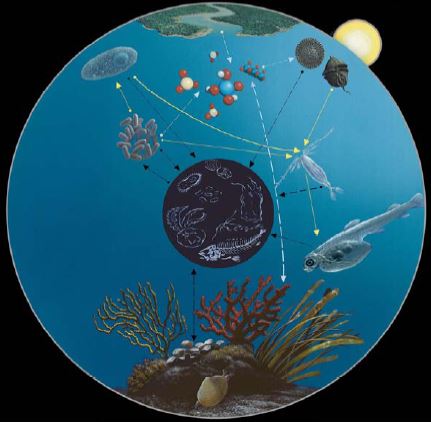1.2 The blooms
The whole functioning of marine ecosystems is based on blooms, i.e. on pulses of primary and secondary production due to the sudden increase in the population size of some key species. The spring bloom of phytoplankton, in temperate seas like the Mediterranean and the Black Seas, is determined by a peak of primary production of planktonic protists (the phytoplankton) that are usually diatoms or flagellates.
The phytoplankton pulse is followed by a zooplankton pulse that takes advantage of the phytoplankton. Crustaceans, especially copepods, are the main representatives of herbivorous zooplankton. The zooplankton peak sustains the rest of the food web, being predated upon by carnivorous plankters. Among these, fish larvae and juveniles are prominent, eventually to become the well-known representatives of nekton: the fish. The pathway phytoplankton > herbivorous crustacean zooplankton > carnivorous zooplankton > fish (Fig. 4) is the backbone of marine production and sustains also our exploitation of marine resources, through fisheries.
The species forming the nodes of this pathway are part of a system that functions due to production pulses (the blooms). If the pathway is sustained, the ecosystem produces fish that, in their turn, realize complex pathways within the fish universe. Small fish are fed upon by larger fish, and most of the nekton seems to be self-sufficient. But this is just an impression. Primary production must be at the base of food webs, and primary production is mainly the phytoplankton pulses. The impression of self-sufficiency of the fish domain reveals its weakness if we consider fish as life cycles, and not just as the adults we feed upon. Fish larvae and juveniles are often carnivorous, but they feed on preys that are herbivorous: the copepods and other crustaceans that rely on the phytoplankton pulses. An ecosystem cannot function with carnivores only!

Figure 4. The pathway phytoplankton > herbivorous crustacean plankton > carnivorouszooplankton > fish (art by A. Gennari, graphics by F. Tresca).